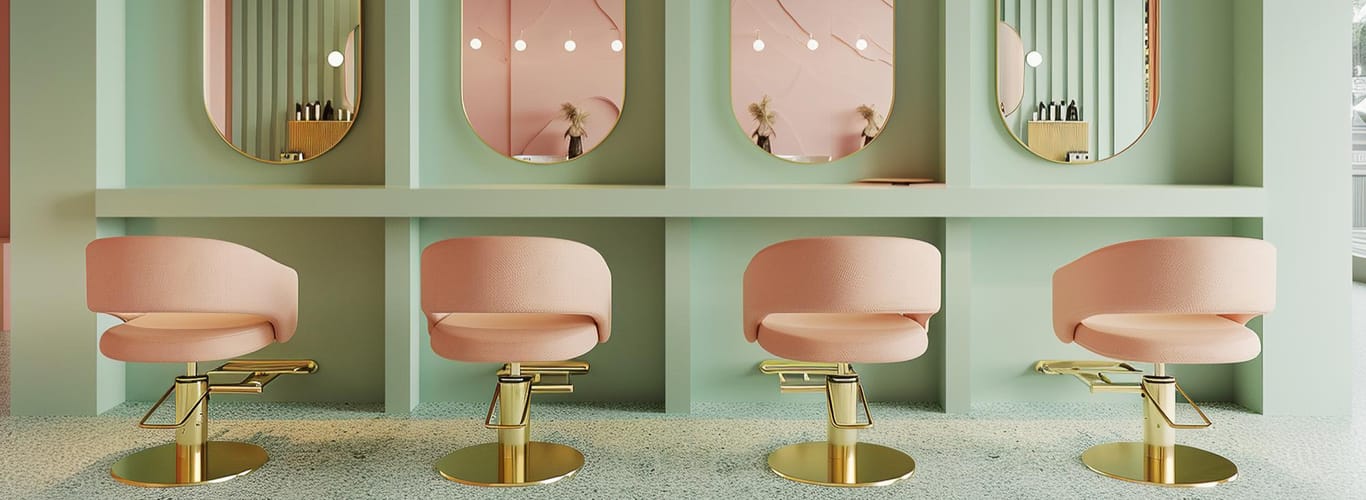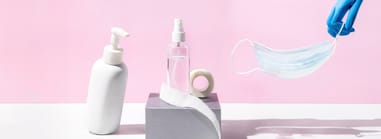Salon equipment: buying, leasing, or renting? Pros & cons
Opening a new salon or upgrading your equipment is an important step! But before you dive in, a critical decision awaits: how will you acquire the equipment you need? Should you buy, rent, or lease?
Understanding these options can be hard, as the best choice depends entirely on your salon's unique goals. This article will unveil the pros and cons of each method, helping you select the perfect fit to empower your salon's success. Read on and discover how to make an informed decision.
Buying: a deep dive
Buying offers long-term benefits but requires a significant upfront investment. Here's a breakdown to help you decide if it's the right choice for your salon.
Pros of buying salon equipment
- Ownership and control. You have complete control over the equipment. You can customize it, upgrade it (within reason) as needed, and keep it for as long as it functions effectively. This is particularly beneficial for high-quality, long-lasting equipment like ergonomic styling chairs or specialized facial steamers.
- Financial benefits. Ownership builds equity in your business. As the equipment depreciates (loses value over time), you can claim tax deductions for depreciation. Additionally, once fully paid for, you eliminate ongoing rental fees, freeing up cash flow for other areas.
Imagine you purchase a top-of-the-line haircutting station for $5,000. You can potentially deduct a portion of that cost from your taxes each year for several years. This allows you to recoup some initial investment.
Cons of buying salon equipment
- High upfront cost. This can significantly impact your cash flow, especially if you need to equip your entire salon at once. Carefully consider if financing options might be helpful to spread out the cost.
- Maintenance and repair. You're responsible for maintaining and repairing the equipment. Factor in potential service contracts or set aside a budget for unexpected repairs. For instance, a high-pressure steamer might require annual maintenance to ensure optimal performance.
- Obsolescence. The beauty industry can evolve quickly. Technology might advance, rendering your equipment outdated. Consider how long the equipment will likely remain relevant before making a purchase decision. For example, a basic hairdryer might be a safer purchase than a cutting-edge laser treatment machine, as the technology in hair dryers changes less rapidly.
Here are some additional factors to consider when buying equipment.
- Research thoroughly. Compare features, warranties, and brand reputations before committing. Read online reviews and consult with other salon professionals.
- Focus on quality. While upfront costs might be higher, investing in well-made, durable equipment can save you money in the long run by minimizing repairs and replacements. This is especially true for heavily used items like styling chairs or shampoo bowls.
- Consider pre-owned equipment. You can find gently used, high-quality equipment at a significant discount. However, ensure the equipment is in good working order and comes with a warranty if possible.
By carefully evaluating your salon's needs, budget, and future plans, you can make informed purchasing decisions that contribute to your long-term success.
Create a thriving nail salon!
Dream of a booming nail salon? Our nail salon business plan delivers expert strategies to build a profitable business from the ground up. Download now — make your vision a reality!
Oh no! We couldn’t subscribe you ☹️
Done! We've sent a link to your Email 📨
Leasing beauty salon equipment: a closer look
Leasing is essentially a financing agreement where you acquire equipment and make fixed monthly payments over a predetermined period. In most cases, the lease has a purchase option at the end, allowing you to own the equipment for an additional fee.
Let's explore the details of leasing and how it might benefit your business.
Pros of leasing salon equipment
- Preserves cash flow. The biggest advantage of leasing is that it requires a much smaller upfront investment compared to buying. This allows you to conserve your working capital for other business needs like marketing, inventory, or staff training. For example, instead of spending $10,000 upfront on a microdermabrasion machine, you could potentially lease it for a monthly payment of $200.
- Access to cutting-edge equipment. Leasing allows you to acquire the latest technology and equipment without a significant upfront investment. This can be particularly beneficial for rapidly evolving technologies like laser hair removal or skin tightening devices. By leasing, you can stay at the forefront of the industry without breaking the bank.
- Potential tax benefits. Lease payments may be considered tax-deductible business expenses. Consult your tax advisor to understand the specifics of your situation.
Cons of leasing salon equipment
- The total cost can be higher. While the monthly payments might seem manageable, the total cost of leasing over the entire lease term can be higher than buying outright due to added interest charges. It's crucial to compare the total lease cost with the purchase price before deciding.
- Limited ownership during the lease. You technically don't own the equipment during the lease term. This means you might have limitations on modifications or customizations. Additionally, some leases restrict how you can use the equipment.
- Ownership at the end might require additional cost. While some leases offer ownership at the end of the term, there might be an additional purchase option fee. Factor this cost into your overall decision.
Leasing can be a strategic tool for beauty salons, especially for startups or those looking to stay updated with the latest technology.
However, it's crucial to carefully evaluate the total cost of the lease compared to buying outright. Here are some additional tips for a successful lease experience.
- Negotiate the terms. don't be afraid to negotiate lease terms like interest rates, purchase options, and maintenance inclusions.
- Read the fine print. understand any limitations on usage, modifications, or early termination fees before signing the lease agreement.
- Compare offers. get quotes from multiple leasing companies to ensure you're getting the best deal.
By carefully weighing the pros and cons of leasing and considering your specific salon's needs, you can make an informed decision about equipment acquisition.
Differences between leasing and financing salon equipment
While some may confuse financing with leasing, it's important to understand the key distinctions. Financing and leasing equipment for your salon, while similar at first glance, have some key differences. Here's a breakdown to help you choose the better option.
The core difference.
- Financing. You borrow money to purchase the equipment outright. You own it from the start and make payments to pay back the loan with interest. Think of it like a mortgage for your house, but for salon equipment.
- Leasing. You essentially rent the equipment for a set period with fixed monthly payments. You don't own it during the lease term, but you might have the option to purchase it at the end for an additional fee. It's similar to renting an apartment, but for equipment.
Here's a table summarizing the key differences.
| Feature | Financing | Leasing |
|---|---|---|
Ownership | You own the equipment after paying it off. | You don't own the equipment during the lease term, but potentially own it at the end. |
Upfront cost | Typically requires a down payment, but less than the full cost. | Lower upfront cost compared to buying outright. |
Monthly payments | Usually higher than lease payments due to paying back principal and interest. | Typically lower monthly payments as you're not paying for ownership. |
Flexibility | You can customize and modify the equipment as needed. | May have restrictions on modifications or usage during the lease term. |
Tax benefits | Loan interest might be tax-deductible. Consult your tax advisor. | Lease payments might be tax-deductible as a business expense. Consult your tax advisor. |
Total cost | Generally less expensive than leasing in the long run (excluding potential repairs). | Can be more expensive than buying due to interest charges over the lease term. |
By carefully weighing these factors, you can make an informed decision that supports your salon's financial health and growth goals.
Renting beauty salon equipment: a flexible approach
Renting allows you to acquire equipment for a temporary period, typically days, weeks, or months, for a set fee. Think of it like borrowing a tool from a neighbor – you use it for a specific project and then return it.
Let's delve deeper into the world of equipment rentals and explore how they can benefit your business.
Pros of renting salon equipment
- Low upfront cost. This is the biggest advantage. Renting eliminates the significant upfront investment required for buying salon equipment. This can be a lifesaver for startups or salons on a tight budget.
- Flexibility. Renting allows you to adapt to changing needs. Need a specific styling chair for a visiting stylist? Rent one for a few days. Thinking of adding a new service like spray tanning? Rent the equipment to test market demand before committing to a purchase.
- Reduced risk of obsolescence. The beauty industry is constantly evolving. Renting allows you to stay updated with the latest technology without the risk of your equipment becoming outdated quickly. For example, you might rent a new model of teeth whitening machine to see if it performs better than your current one.
You're considering adding brow lamination to your service menu. Renting a lamination kit allows you to experiment with the technique and see if there's enough client demand before investing in purchasing your own kit.
Cons of renting salon equipment
- Higher overall cost. While the upfront cost is low, rental fees can add up over time, especially for long-term rentals. In the long run, buying might be more cost-effective.
- Limited control. You don't own the equipment, so you have limited control over its condition or how it's been used previously. Be sure to thoroughly inspect rented equipment before using it on clients.
- Not all equipment is available. Renting might not be an option for all types of equipment, especially large, expensive items or those requiring specific installation.
By understanding the advantages and limitations of renting equipment, you can make informed decisions that support your salon's growth and financial well-being. Remember, renting can be a great way to test the waters, manage short-term needs, and adapt to a dynamic beauty industry.
Unleash your business potential
You're on the right track! Find out even more expert advice in our new article.
Read nowConclusions
Equipping your salon involves a strategic choice:
- Buying offers long-term ownership and potential tax benefits, but requires a significant upfront investment.
- Leasing provides access to cutting-edge equipment and preserves cash flow, though total costs can be higher.
- Renting is perfect for short-term needs, testing new services, and keeping upfront costs low, but might not be cost-effective in the long run.
The best option depends on your salon's specific needs and financial situation. Carefully consider your budget, equipment lifespan, and future plans to make an informed decision that empowers your salon's success!
 The latest articles and industry insights delivered to your inbox
The latest articles and industry insights delivered to your inbox
Subscribe to receive a monthly digest of our most valuable resources like blog posts, whitepapers, and guides.
Oh no! We couldn’t subscribe you ☹️
Done! You've subscribed 💛
Unsubscribe anytime. Your data is stored for business-to-business communication purposes. See our Privacy policy.
Last updated on May 02, 2024
“What Changed” in this article? Everything. It's packed with the latest findings, the ripest data, and a fresh analysis you won't find anywhere else.
A subject-matter expert wrote the content, and reliable, official sources support it. Recent research has been incorporated to maintain relevancy and accuracy.
Please share this post
Table of Contents
Buying: a deep divePros of buying salon equipmentCons of buying salon equipmentLeasing beauty salon equipment: a closer lookPros of leasing salon equipmentCons of leasing salon equipmentDifferences between leasing and financing salon equipmentRenting beauty salon equipment: a flexible approachPros of renting salon equipmentCons of renting salon equipmentConclusionsSalon recruitment plan: 5 tips for building a stellar team
Unlock the secrets to assembling a dream salon team with our guide. Learn the ins and outs of creating a successful salon recruitment plan, from defining your needs to onboarding.
Beauty salon operations & Team management
5 min
The ultimate guide to salon hygiene and infection control
Discover the essentials of salon hygiene in this guide. Learn practical tips and legal requirements to keep your beauty business clean, safe, and thriving.
Beauty salon operations & Team management
7 min
Inventory control differences across salons, spas, and barbershops
Inventory control isn’t glamorous, but it makes or breaks beauty businesses. This article reveals the differences in salon, spa, nail, barbershop, and medspa inventory management — and shows how to cut waste while boosting profit.
Inventory management in beauty business
10 min
Unlock FREE bonus material!
Get your hands on "Beauty salon business plan". Subscribe to our newsletter and receive a link to download it straight to your inbox.
Oh no! We couldn’t subscribe you ☹️
Done! We've sent a link to your Email 📨
Trusted by the best in the beauty industry.
Transform your beauty business with Suplery!
Already enjoying our expert tips? Take the next step and join Suplery to revolutionize your business operations.
Huge range of professional products
One-click checkout after first order
Automated predictive orders
Seamless inventory management
From words to action
Start working with Suplery and explore all the tools and services you need to expand your business
Get started with Suplery24/7 Support
Secure payments
Designed by industry’s experts







